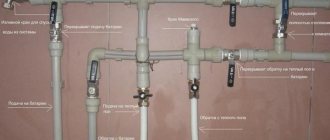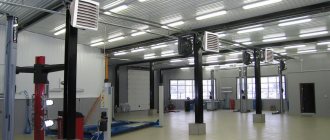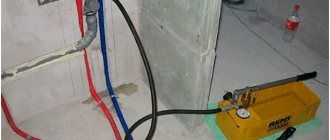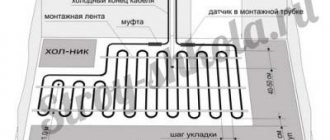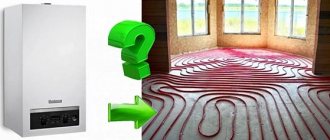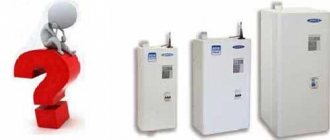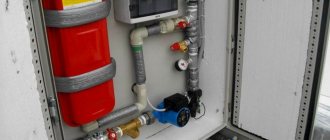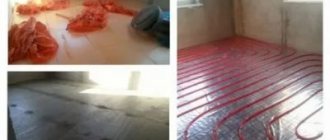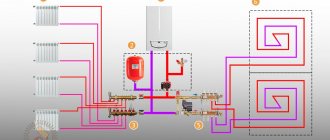Home / Electric boilers
Back
Published: 06/05/2019
Reading time: 4 min
0
3887
For a comfortable atmosphere, owners of houses or apartments install high-quality heating equipment. And in order to provide full heating of all rooms, an electric boiler for underfloor heating is installed. It is often difficult for users to decide on the model and select the power of the electric boiler.
- 1 Which electric boiler to choose for underfloor heating
- 2 Calculation of electric boiler power for heated floors
- 3 Requirements for installing heated floors with an electric boiler 3.1 How is the equipment installed?
Scheme of proper installation of a warm water floor
There is one rule for all pipe laying schemes - installation of pipes must begin from the walls and move towards the center of the room, and then lead the pipes to the exit of the room. The layout of heating pipes is very important for saving heat.
The advantage of a snake is its ease of installation. The pipe is laid, sequentially moving in a zigzag from one wall to the opposite
Laying schemes:
- Snake;
- Snail;
- Combined installation.
It is necessary to consider all 3 heating installation schemes. Snake - pipes run along the perimeter of the room near the walls, and then from one of the walls (this will most likely be an internal, warmer wall) returns back in a wave.
Snail - pipes follow the perimeter of the room and each circle narrows, approaching the center. This scheme will be especially applicable for rooms with 2 external walls (corner room) or a room located on the north or east side. The combined scheme combines both the first and second schemes. But in any case, it is necessary to make a detailed drawing of the layout of the pipes in the room.
Prefabricated manifold systems
A complete manifold system, along with shut-off valves and temperature regulators, includes:
- mixing unit;
- drain tap;
- air exhaust;
- a pump that circulates liquid in pipes.
An analogue to a shut-off valve at the inputs/outputs can easily be a valve with a control thermostat. The main advantage of these devices is their ability to contract and expand depending on the set optimal temperature, setting the intensity of the flow of heated liquid.
The mixer pump must be installed between the supply clamp and the supply pipe, while the third outlet goes to the return and is located in front of the return clamp. The resulting connection will allow the pump to take cooled liquid from the system and transfer it directly to the supply.
Connection features
Before piping the heated floor and gas equipment, it is necessary to prepare the manifold and the heated floor system itself. A warm water floor can be connected to a water heater or other type of gas equipment in the following ways.
Collector option
This method is based on piping the boiler, distributors and pipes. The location of the manifold cabinet should be convenient: return and supply should be brought here. But first you need to install shut-off valves on the collectors. It may include a thermometer to visualize the temperature regime.
So, for example, when purchasing a ready-made manifold cabinet, it is better to give preference to branded brands that already have the necessary taps at all cabinet outlets.
Pipelines, taps and manifold systems are connected to each other using fittings, and manifolds and floor piping are connected to special connectors, which contain clamps, bushings and nuts. If the hole diameters do not fit together, then adapters are used. In this example, it is necessary to connect the return and supply with pipelines and valves, and the collectors with underfloor heating pipes. This is one of the simplest ways to install a heated floor.
Complete manifold-based system
In addition to shut-off valves, there are also:
- Three-way valve.
- Air vent.
- Drain tap.
- Circulation pump.
In practice, it is often common to replace shut-off valves at the inlet and outlet with thermostatic adjustable taps. With their help, you can regulate the throughput, thanks to the thermal cylinders installed in them. The three-way valve is responsible for mixing the return and supply, which is necessary to lower the temperature of the water circulating over the heated floor, which can be laid on wooden beams.
The mixing pump will help organize the intake of water flow at a minimum temperature, after which it will add it to the supply. To do this, the pump must be installed between the pipeline and the supply manifold, and the third outlet must be connected to the return line in front of the return pipeline.
Mixing valve circuit
In this option for connecting the boiler and circulation system, instead of a mixing pump, a three-way mixing valve is used. To use this scheme, the circulation of the water flow must be good.
The installation of this element must be carried out at the return outlet from the collector. Pipes from the boiler unit are connected to the collectors on one side, and on the other there is a splitter for each of the collectors. An air vent is connected to the splitter device at the top, and a drain valve is placed at the bottom.
Connection diagram using a circulation pump
Mainly used for connection to central heating. It is installed on the return line so that there is more heat in the radiators. However, to reduce the heat flow, such a pump is often installed on the supply side.
The use of a condensing boiler in a heated floor system is beneficial when there is a cold return.
Which boilers can be combined with heated floors?
The best boiler option for heating floors is an electric boiler. Moreover, regardless of whether it is a heating element, induction or electrode. It has optimal efficiency even when operating at low power. In a small house, such equipment can be connected directly to the floor heating system. In large rooms it is better to make the connection using a special distribution and mixing unit.
The boiler operates automatically and requires virtually no human control. It is easy to install and easy to maintain.
Autonomous circulation group Isoterm Watts 44.02.070
You can also use condensing gas boilers, which can operate efficiently with a slight heating of the coolant. But conventional gas units require the installation of a mixing unit, which will have control elements. This is an excellent option for combining radiator heating and a heated floor system.
Solid fuel and liquid fuel boilers are not the best option, although they can also be used to organize a floor heating system. They require the installation of a mixing unit with thermometers, controllers and other additional equipment. Yes, and it is very difficult to adjust the desired temperature with their help - sometimes they produce too hot a coolant, sometimes too cold.
Principles of technology for connecting a heated floor to a heating system
Conclusions and recommendations
For successful and long-term operation of the underfloor heating system, it is allowed to use any currently existing boiler. It is not the type of heating unit that plays a role, but its correct connection to the underfloor heating distribution manifold. Other selection criteria, such as power, functionality and type of energy carrier, are selected using a standard algorithm.
By choosing a heat source and knowing the risks of combining it with heated floors, you can select equipment and piping elements in advance. This will give you a future picture of the financial costs of installation, from which the payback of a specific heating system is calculated.
Think twice before introducing underfloor heating without a radiator. If you have high requirements for the interior design of rooms and you do not want to see heating devices under the windows, use a more modern solution - baseboard convectors or air heaters built into the floor.
System and stages of installation of a warm water floor
The technology for concrete screed is the simplest. The first thing to do is to clean the floor of old floor coverings and cement all cracks and potholes.
Any work begins with drawing up a plan and preparing the workplace
Thermal water floor installation system:
- Cleaning and leveling the subfloor;
- Waterproofing;
- Installation of edge insulation around the perimeter of the room;
- Thermal insulation;
- Reinforcement;
- Installation of heating pipes;
- Connecting heating pipes to the boiler;
- Trial;
- Pouring the floor with concrete or cement screed;
- Break – 1 month;
- Sound insulation device;
- Decorative flooring.
It is also necessary to check the floor level; if the difference is up to 1 cm, then you can ignore it, but if the difference is more than 2 cm, then you need to level the floor with a cement screed and allow the surface to dry for at least 2 weeks. Next, you need to waterproof the floor in case of hot water leakage from the pipes
Along the perimeter of the room, apply edge insulation with damper tape to the height of the proposed floor. Thermal insulation is the next stage of action. The insulation must be laid throughout the room; the minimum thickness of the insulation is about 2–5 cm. Next, reinforcement should be carried out over the entire surface of the room. To do this, you need a purchased reinforcing mesh with cells of 16–21 cm. It is to this mesh that the heating pipes will be attached, because they bend perfectly. The pipe routing is secured using special plastic ties or clips (track).
Emergency strapping options
Whichever heating system option you choose, dual-circuit heating systems must have an emergency circuit that will act as protection in the event of various unusual situations, for example, if the electricity is suddenly cut off. There are several ways to cope with this problem.
Boiler emergency piping diagram
The supply of water from the water supply system to the system is used quite rarely, as it is ineffective. The whole point is that the plumbing system stops working when the power goes out. A certain amount of water is stored in hydraulic accumulators, however, this amount will simply not be enough to prevent overheating of the equipment. If antifreeze is used as a coolant, then approximately 150 liters of this expensive substance will simply be drained into the sewer system.
If you connect the circulation pump to an uninterrupted power source, you can be safe from a power outage in the network. However, this solution also has its drawbacks. This power supply may not work due to some unexpected situations. In addition, boilers with a double-circuit system require constant maintenance and preventive maintenance. It is constantly necessary to monitor the health of the batteries and check for serviceability by charging and testing their performance.
The circuit protects the heating system from overheating
The concept of gravitational circulation refers to a special circuit, which is characterized by small dimensions and serves to remove excess thermal energy in the heating system. This circuit must be turned on only after the pump is turned off, which will lead to the fact that not the entire building, but some part of it, will be heated.
One of the most effective methods is to create an emergency circuit. It is an indispensable component of any good heating system. Thanks to this circuit, the gravity and forced circuits can function in different parts of the system as usual. However, when the pump is turned off, only the gravity circuit will work.
So, we have discussed the main functions and technical characteristics of existing electrical boiler piping schemes. You only need to make your choice, relying on your technical knowledge, family budget and the general design of the heating system in your home. Having weighed all the nuances and settled on the scheme that is ideal for your home, you should proceed directly to installation.
Electric and solid fuel
There are several types of boiler equipment, differing primarily in the type of fuel used. The most popular are:
- Electric.
- Solid fuel (pellet) boiler.
- Gas equipment.
Pellet
Despite the fact that in recent years there has been almost universal gasification, gas-powered equipment is still rarely installed in rural areas. Its main area of application is city apartments and country cottages, which are close in terms of living comfort to the conditions of a metropolis. In villages, solid fuel equipment is more often installed - a wood, pellet or coal boiler.
The most important advantage that distinguishes a solid fuel (pellet or wood) heating boiler is its low cost and ease of operation. In rural areas, firewood remains the cheapest fuel to this day, and the likelihood of supplying gas to remote corners of the country is still almost a fantasy.
Electric
An electric heating boiler has a lot of advantages, but all of them are covered by one significant disadvantage - high operating cost. In some ways, the following can also be considered disadvantages of the equipment:
- Volatility of the system. A power outage will have negative consequences for the entire heating network, and not just for the device itself. To minimize the risk of the system defrosting in the event of a power outage, an additional emergency generator will be required.
- The electrical network must be able to withstand significantly increased load. An additional line may be required. You will definitely need to install a separate machine.
- The device must be connected by a qualified electrician. Unprofessional installation is life-threatening.
According to the principle of operation, electrode and heating element electric boilers are distinguished. We will not dwell on the former, since it is extremely difficult to design and install such a device. Let's take a closer look at heating elements devices.
Design Features
The electrodes in the boiler need to be changed periodically
Inside the body of such a device there is a liquid in which two electrodes are immersed. They are supplied with alternating voltage with a frequency of 50 Hz. Particles located between the electrodes move in the desired direction depending on their polarity. This movement of ions is continuous, since the polarity of the particles changes very quickly.
Related article: Choosing a bathroom faucet with spout
Despite the fact that such electrodes cannot burn out, they still have to be changed periodically. In addition, you need to monitor the quality of the liquid by purchasing a ready-made mixture or adding the right amount of salt to drinking water.
Another option is induction units. They heat up a conductor immersed in a magnetic field. An inductor is wound around the core, the role of which in such models is played directly by the device body.
The body of the unit resembles a labyrinth, flowing through which water heats up and cools its walls.
This equipment is one of the most expensive devices, but it almost never fails, delighting the consumer with its durability and practicality.
Induction electric boiler
Having appeared relatively recently, boilers of this type have already gained enormous popularity. The principle of their operation is quite simple: a functioning device generates electromagnetic waves that interact only with metal. They do not affect other materials in any way, therefore, even with direct contact with the boiler, it is impossible to get burned.
An induction boiler consists of two main elements:
Emitter
- emitter;
- a pipeline with circulating liquid that receives radiation.
The pipeline (another name is the receiver) has quite large dimensions, therefore, if plaque forms on its internal walls, this will not affect the efficiency of work soon.
Pipeline (another name is receiver)
Advantages of induction boilers
Among the positive qualities of this device it is worth highlighting:
- reliability;
- safety;
- possibility of using any type of coolant;
- protection against plaque;
- Constantly high efficiency;
- quick access to working mode;
- no detachable connections.
Making an induction boiler
Induction heating boilers
The design of these boilers, just like heating elements, is quite simple, so if you wish, you can do it yourself. You just need to prepare:
- welding inverter;
- wire cutters;
- grinder;
- steel wire;
- stainless steel wire rod;
- plastic pipe with thick walls;
- adapters;
- metal mesh;
- enameled copper wire.
Stage 1. The material that will be irradiated with electromagnetic waves will be small pieces of wire rod or steel wire ø7 mm. The maximum length of the segments is 5 cm.
Stage 2. You need to make the case. It will simultaneously:
- the basis for creating an induction coil;
- part of the heating main.
To make the body, a plastic pipe with an internal diameter of slightly less than 5 cm is used.
Stage 3. Adapters are used to connect the boiler to the water supply. Through these adapters, cooled coolant will flow into the boiler, and heated coolant will go back into the pipeline. At this stage, the first adapter is attached to the base.
Stage 4. An iron mesh is laid at the bottom of the structure. It will prevent pieces of wire from getting into the line.
Stage 5. After this, the wire itself is filled in. There should be just enough to completely fill all the free space of the container. The upper part of the housing is closed with a second adapter.
Stage 6. After creation, you can proceed to the main thing - the induction coil. Enameled copper wire is taken and wound around the body in ninety turns. They should be placed approximately in the center of the structure.
Step 7. Then the electric heating boiler should be connected to the heating system. To do this, a small section is cut out of the pipeline, and a structure is attached in its place.
Stage 8. The coil is connected to the inverter, the system is filled with water.
Consultation on choosing an electric boiler for heated floors
Heating systems based on warm water floors are used in homes, offices, and commercial real estate. For heating, electric boilers are often used, which are characterized by their compact size, affordable price, and high degree of automation. By installing a GSM thermostat for a boiler of this type, you can control the heating system using a smartphone. All this, along with a wide range of equipment, attracts potential customers. Many domestic and foreign manufacturers produce electric boilers. Are there any particularities in choosing equipment for a heated floor system and which model should you choose?
Basic requirements for boilers
The water temperature in heating radiators can exceed +70ºС; such parameters are not relevant for heated floors. If you heat the heated floor to such parameters, then it will be impossible to walk on it barefoot, and the living room will turn into a sauna. The maximum temperature of the water leaving the electric boiler should not exceed +55ºС. In this case, the floor temperature will be slightly below +30ºС, which will ensure the maximum level of comfort in the house. Accordingly, electric boilers that are planned to be used in a heated floor system must be equipped with temperature control systems in the region of the specified limit. For most models with heating elements, this possibility exists, but for electrode-type boilers, the minimum coolant temperature does not fall below +60ºС. If such equipment has already been purchased, then you need to take care of the cold water mixing unit.
Additional criteria for choosing a boiler for heated floors
Other parameters for choosing heating equipment are similar to those that have to be analyzed for equipment used in a traditional heating system. This does not make them any less important; they must be taken into account. The property owner will need to decide on the following characteristics:
- power;
- type of installation;
- number of circuits;
- availability of automated security systems;
- functionality.
The boiler power must be sufficient to heat a room of a certain area. For a cottage of 300 sq.m. Heating equipment with a power of at least 30 kW is required. It can be wall-mounted or floor-mounted - the type is selected based on the available space in the house and the weight of the equipment. Powerful boilers are heavy and mounting them on the wall is not advisable.
You can use both a double-circuit and a single-circuit boiler for a heated floor system. The presence of automatic systems that monitor safety is mandatory. You can neglect the automation of the control system, since the GSM thermostat is in some cases more functional. It allows you to control heating via your phone, which saves energy as much as possible and provides a high level of comfort.
Some manufacturers offer electric boilers that are functionally designed for heated floors. Such models do not require additional equipment for connection, which makes installation less expensive. If the boilers are not functionally designed for heated floors, then most likely you will need a comb, temperature sensors and a mixing unit. This equipment will allow you to supply coolant with an optimal heating temperature to the system.
One of the main problems of owners of electric boilers is reducing energy costs. They can be minimized by installing automation that operates through sensors installed at a height of 15-20 cm from the floor.
They reduce the heating level and maintain a comfortable temperature. An alternative to them would be a GSM thermometer, which allows you to control the temperature of the coolant and maintain it at a minimum when there are no inhabitants in the house. You can ensure a comfortable temperature with one SMS message shortly before returning to the owners’ home.
Briefly about choosing power
Electric boilers for heated floors are not required to provide extremely rapid heating of the coolant, but must have sufficient power. The rule for choosing a specific model is as follows:
- the device must have 1 kW of power for every 10 sq.m of surface under which the heating system is laid;
- for double-circuit boilers, the power indicator should be increased by 25-30%, later this factor will be covered in detail;
- To stabilize the temperature in a house or apartment as a whole, it is recommended to increase the calculated power by 5-10% if the area of corridors, storage rooms and other unheated areas is large enough.
When calculating the target heater power, you may end up with a fractional figure. It is rounded up, and the choice of boiler is made on the condition that its passport indicator corresponds to the received figure or a little more.
Watch the video on how to choose an electric boiler.
Advantages and scope of electric boilers
Most often, electric boilers are used in dachas and private homes. This is due to the fact that this equipment has a low cost and at the same time you can install it yourself, without calling a specialist.
Among the main advantages of electric boilers are:
- the equipment is safe (the design does not include open flames or the presence of flammable fuel sources);
- water heaters can be switched off for up to six months, without harm to their performance (relevant for dachas and country houses that are rarely visited);
- the dimensions are relatively small, so it can be placed in any room;
- Today there is a huge variety of electric boilers, varying in power, installation method and principle of operation;
- When water is heated, soot does not appear, which is dangerous for both humans and the environment.
Types of equipment
The larger the area of the water circuit, the more powerful the heating unit should be
When choosing heating equipment, first of all you need to pay attention to such characteristics as:
- number of circuits;
- heating features;
- installation method.
Electric boilers for heated water floors can be installed on the floor or fixed to the wall. The floor-standing heating element device is distinguished by its significant weight. It is equipped with a boiler, the internal structure of which includes not only an insulated container, but also a tubular heater.
Dual-circuit appliances allow you to separately heat water for domestic needs
Among the boiler equipment models on the market, the most popular are two types of devices:
- single-circuit;
- double-circuit.
Both heating elements and electrode electric boilers can be single-circuit. Both of them carry out activities aimed at heating the liquid, which acts as a heat carrier. Double-circuit heaters also heat the coolant - water for hot water supply. For this purpose, exclusively heating elements are used.
The installation of this equipment is justified by the fact that it is possible to use a two-tariff meter.
This means that the liquid is heated at night, and heated floors are heated during the day.
Speaking about the heating principle, it is worth mentioning the convenience of electric heating elements. Their main distinguishing feature is a wide power range, which is easy to adjust.
Heating cost
For now, the cheapest type of heating is gas. But the situation may soon change: it is rapidly becoming more expensive. In the meantime, when installing a gas boiler for a warm water floor, you will pay the least for the energy used monthly.
Second place goes to fuels that are unusual for our country - pellets and fuel briquettes. If we compare the cost of a ton of firewood and pellets, then pellets are more expensive, but in terms of the cost of a kilowatt of heat, the use of pellets/briquettes is cheaper. These small granules are produced from waste from the wood processing industry or crop production. At the same time, their calorific value is higher than that of the best firewood, and for the highest quality pellets it is even comparable to the amount of heat generated by some brands of coal. And at the same time there is ten times less waste (ash). Fuel briquettes can also be included in this category. It’s just that pellets are usually used in special installations, and briquettes can be used to heat ordinary solid fuel boilers.
Pellets and fuel briquettes are not yet widely used in our country, but heating with them is economical. We are also pleased with the high degree of autonomy of operation of units using this fuel.
The third and fourth places are contested by firewood and coal. In some regions it is more profitable to heat with wood, in others -.
Fifth place for liquid fuel - it's not cheap. Operating costs also include the need to heat the fuel tank, or install the tank in a heated room. In addition, installations using diesel fuel require a boiler room. Moreover, it is better to build a boiler room at a decent distance from the house: the noise during operation of the burner is decent, and the smell is strong, and it penetrates everywhere.
It is generally accepted that the most expensive heating is electricity. But when using automated modern devices you have to pay only a little more than when using coal or firewood. So don’t discount electric boilers for heated floors. It’s just that for more economical heating, it is advisable for you to take a heating unit with the ability to adjust the power. In some traditional electric boilers, heating elements are assembled in groups, and automation, turning the groups on/off, regulates the operating power and saves energy. For heated floors, it is advisable to take a three-stage, or, in extreme cases, a two-stage unit. Induction and electrode boilers themselves are economical (if controlled electronically) and have low inertia, that is, they do not waste energy.
Heating cost depending on the type of fuel used
Types of boilers for water floor heating
There are several types of boilers for heating the coolant, that is, water. They differ in the features of operation, installation and operation, as well as the type of fuel on which they operate.
Heating boilers
Table. Types of heating boilers.
| Type | general information |
| Single-circuit | Such boilers heat only the coolant (in our case, water). In order for them to be used for anything else, boilers, heat exchangers, etc. must be purchased. |
| Dual-circuit | Boilers of this type can be used to heat water and for heating purposes. Heating in such a unit is possible due to the presence of a heat exchanger or boiler directly in the device itself. |
Boilers can also be divided into two categories based on their installation location. They are wall-mounted and floor-mounted. Floor-standing ones, as a rule, have more power than suspended ones. But the latter are much more convenient to install and less expensive to maintain.
Installation of a BAXI gas boiler + Protherm electric boiler
Diesel boilers
In this case, the fuel is ordinary diesel fuel. These units are productive and very efficient, they are completely autonomous, that is, they do not depend on whether they are connected to any communications (gas, electric networks, etc.). They are easy to install, easy to operate and have high efficiency rates with low fuel consumption.
Diesel boiler design
diesel heating boilers
Solid fuel boilers
The fuel for these units is firewood and fuel pellets. The operating principle is similar to burning wood in a conventional stove. But in this case, combustion occurs at high temperatures (from +250 degrees) and without air access. Heating of the coolant occurs due to the release of hot smoke during fuel combustion.
Solid fuel boiler for heated floors
Such boilers are rarely used in residential premises; their usual areas of use are manufacturing and agriculture. These units in the house require constant attention, as well as fuel loading, which complicates operation.
Solid fuel boiler diagram
solid fuel heating boilers
Gas boilers
It is not difficult to guess that this type of boiler runs on gas. The body of these devices is usually made of cast iron or steel, which will determine the service life and ease of installation. Steel boilers are much lighter than cast iron, they are small in size and easy to repair. However, their service life is shorter. This is why cast iron units are more expensive, as they are characterized by increased reliability. The devices can operate on both main gas and liquefied gas from cylinders. They are quite economical, and for heating only floors you can use a low-power unit.
Gas boiler for heated floors
These boilers are not recommended for connection to a heated floor system. The reason is simple - they, of course, are able to maintain the water temperature at low levels (about +45 degrees), but in fact they are designed to heat the coolant at least +80 degrees. Because of this, the efficiency of the boiler will drop greatly (up to 15%).
But there is still the option of using a gas boiler to work with a heated floor system. To do this, you will have to use a mixing unit equipped with a special distributor and a circulation pump. However, this will also increase the costs of purchasing equipment and its installation.
Gas floor-mounted double-circuit boiler
gas heating boilers
Electric boilers
These electrically powered units can be used in any application and are best suited for connection to an underfloor heating system. Connecting this boiler is simple, despite its apparent complexity. Such units will allow you to organize low-temperature heating - the kind that is needed for heated floors - due to the ability to adjust the temperature of the outgoing coolant flow.
Diagram of an electric boiler for a warm water floor
In the photo - an electric heating boiler
electric heating boilers
Boiler selection
There are no water heaters that are specifically designed for warm water floors. A number of manufacturers produce devices that have a “warm floor” function, but this mode only limits the level of water heating. In addition, you need to take into account what type of coolant is allowed for this model. There are devices that do not work with antifreeze; this is indicated in the instructions for the equipment.
BOILER FOR WARM FLOOR!
In principle, any model of water heater can service a heated floor, the main thing is to properly wire and connect it.
What are the features of choosing a water heater, and what should you pay attention to:
- Is it compatible with underfloor heating? Is it capable of maintaining the required coolant temperature? Otherwise, you will need to select additional equipment.
- How efficiently it will work in the system - this indicator affects the consumption of the resource (fuel).
- Is it easy to maintain and operate? How long will it take to set it to the desired heating level?
- Are there any installation difficulties - can you install it yourself?
In addition, heat generators must be selected depending on the area and operating conditions, with attention paid to:
- Power - it is determined taking into account the size of the heated room and the degree of its insulation. The documents indicate the area for which the device is intended, subject to high-quality insulation. If you do not know the heat loss of the house, then the power should be taken with a margin of 25%. Excessively exceeding the required performance can lead to overheating and equipment failure.
- The presence of a power control function - gas boilers are often equipped with this feature. The adjustment can be done manually or automatically. Automatic models are more economical; you need to set several indicators, and then the automation is responsible for maintaining the temperature at a given level and turning off the heating.
- Energy dependence - the use of an electric pump to force the movement of liquid increases the productivity of the boiler, but makes it less autonomous and dependent on energy resources.
- Type of coolant heating - if the equipment is required not only for heating the room, but also for providing hot water, then a double-circuit flow-through boiler is needed. If you need to heat a large volume of water, it is better to buy a storage model.
Everyone determines the cost of a heater for themselves, based on the cheapest energy source. For some it is gas, for others it is wood. If there is a multi-tariff meter in the house, electricity will be profitable.
An electric boiler is most suitable for hydrofloors, as it is able to maintain the temperature at a given level with low power consumption. 1 kW of electricity is converted into kW of heat. If the heating area is not significant, then it can be connected directly.
To connect a cottage of an impressive area, you will need a mixing unit. When installing gas equipment, you cannot do without a distribution unit, since direct connection is not recommended. And feeding a heated floor from a solid fuel boiler leads to increased costs due to the purchase of additional components.
In addition, installation of gas or solid fuel boilers requires the installation of a boiler room.
Installing the unit
First you need to install an electric boiler indoors. As we have already said, the unit can be floor-mounted or wall-mounted. In the first case, the kit includes a special stand, on which the “landing” is performed.
In order to hang the boiler on the wall, you need to prepare anchors with dowels and a drill with a suitable drill bit. First, mark the wall using a tape measure and a marker.
The holes must be placed perfectly level in a horizontal plane. Next, we drill out the marked places, drive dowels into them and screw in the anchors. After the anchor is firmly seated inside the wall, you can hang the electric boiler.
We draw your attention to the fact that the installation of the electric boiler must be carried out perfectly level in both horizontal and vertical planes. Any misalignment can affect the performance and service life of the equipment
Any misalignment can affect the performance and service life of the equipment.
Installation and Installation
Before connecting an electric boiler to a warm water floor, you must read the instructions supplied by the manufacturer and carry out all work in strict accordance with the instructions received. For more information about connecting a heated floor to a boiler, watch this video:
Collector unit
Required devices include:
- underfloor heating manifold unit;
- expansion tank;
- circulation pump installed on the return line.
As the installation diagram shows, the floor heating boiler is connected to the expansion tank, then you need to install a pressure gauge that controls the pressure in the system, then connect the manifold assembly. It is required to clearly distribute the coolant throughout all installed pipe circuits and regulate the temperature of the liquid in the system.
Now you can connect the heated floor directly, and on the return line you need to install a circular pump, which will ensure rapid and continuous movement of the liquid heat carrier through all pipes.
A prerequisite for efficient and safe operation of the equipment is the presence of its own electrical system output to the switchboard, separate from other devices. Electric boilers are installed to heat country cottages and small private houses, garages and private workshops. They are simple and easy to use, reliable and economical. Such equipment does not require the construction of chimneys and does not pose a fire risk. For details on installing heated floors in an apartment, see this video:
You can connect such a device yourself by choosing the most convenient model. Wall-mounted units take up minimal space and do not attract attention. Modern devices provide a smooth start of the system, are designed with the ability to connect a programmer and are equipped with an LCD display that displays the current state of the system. Electric boilers connected to a warm water floor help create an atmosphere of coziness and comfort in your home, avoiding unnecessary material costs.
Boiler power calculation
An important indicator of a boiler is its power. This figure is a guarantee that the unit will easily heat all rooms. The generally accepted power indicator for electric boilers paired with a water floor is 1 kilowatt per 10 m2 of room area. For dual-circuit models, another 30 percent of performance is added to the figure.
Important! When calculating the power of an installation, the calculation result is always rounded up.
It is important to remember that even when hot water is turned on, the heated floor still continues to heat up. This applies only to dual-circuit installations. This means that the electrical wiring will be overloaded. Therefore, when connecting a communications system, pay attention to the cable parameters allowed in such a system. They must be specified in the boiler manual.
Features of electric heating equipment
There is a widespread belief that all types of electric heaters provide savings of about 30-40%, and installation of an electric heating boiler will be as profitable as possible. The values described are large, and in theory they allow you to save a significant amount on heating.
As a rule, the reason for such efficiency is given as reduced power - that is, when calculating the heating system, it must be assumed that heating one square meter of room requires about 60 W of energy instead of the required 100 W.
Everything said in the previous paragraph is the erroneous opinion of most users. It is not advisable to compare direct heating devices in terms of efficiency, since they will all be equal. This statement is based on the law of conservation of energy, according to which energy cannot appear out of the blue and disappear into nowhere.
In relation to electric heating devices, this means that all generated energy will be converted into heat.
Of course, this phenomenon will be accompanied by certain losses - nevertheless, part of the heat will certainly dissipate in the air and will not be transferred to the coolant. But the volume of losses directly depends on the insulation of the device body, and not on the type of heating equipment. In addition, the heat released outside will directly warm the room where the boiler is installed.
If we look at the problem from the other side, then heating is designed to compensate for heat losses, the amount of which is determined by:
To summarize, we can definitely say that the type of heat source has no relationship with the thermal power required to heat the building - which means that the vaunted efficiency of electrical devices is simply absent.
However, this only applies to efficiency - each electrical device has special performance qualities:
Electric radiators.
Such devices load the electrical network evenly, so there are no wiring requirements.
Induction boilers. Such heating equipment is compact and reliable. The latter quality is due to the fact that there is no heating element in the heat exchanger, and the power controller and coil are located outside, so water does not have any effect on them.
In addition, induction boilers can work with any coolant.
Electrode boilers. Differ in smallest sizes. Such boilers require constant replacement of electrodes, since they dissolve in water over time.
Only water containing a certain amount of salts can be used as a coolant.
Heating element boilers. The main problem of boilers with heating elements is the constant deposition of scale on the heating elements (this factor is irrelevant for closed heating circuits, in which the amount of salts is initially limited). In addition, these devices are quite large in size.
Design and operating principle
Electric boilers have a fairly simple design. All devices are equipped with a heating element and a container for heat conduction. According to the type of heating element, electric boilers are divided into:
- devices with heating elements (tubular heaters);
- induction boilers;
- devices with electrode heaters.
Electric boilers are classified into 3 types Read more: DIY induction heating boiler.
The coolant can be forced to move through the system by installing additional equipment (pumps). Also for this purpose, the elementary laws of physics and the force of earth's gravity can be used. With automatic circulation, the pump is installed at the return inlet.
Device with thermal electric heater
Such devices are considered the most popular due to their simple design and low cost. The heating element (heating element) is installed in a container, where the heat conductor is heated to the desired temperature. When current passes through the heating element’s spiral, it heats up to a high temperature, due to which the liquid is heated.
The heating element is protected from overheating, as water constantly circulates and cools it. To maintain a constant temperature level of the heat conductor, a thermostat is installed that turns off the heating element if the set temperature is exceeded. The device turns on again when the indicators are reduced to the minimum.
It is not difficult to make an electric boiler for heating with your own hands, if you compare its production with other types of heating equipment. It will not have the advantages of purchased analogues, but it will still perform the function assigned to it.
To make your own device, you only need heating tubular elements and a container. But such a boiler should not be considered ideal, since its efficiency will be below 80%. Much also depends on the quality of heating elements, on which scale forms due to salts dissolved in water. It often leads to equipment failure due to overheating. As practice shows, scale with a layer of 1 mm reduces efficiency by 10-15%. But even taking this into account, electrical designs for heating rooms are very popular.
The efficiency of such a device will be far from 100%
Induction devices
Such devices, unlike heating element models, have an efficiency close to 100%. Plus they are durable. Their service life is about 25-35 years, and in addition they can serve as a boiler, heating water. Thanks to energy conversion with virtually no losses, induction boilers have the highest energy efficiency.
However, this type of equipment has not become popular among home craftsmen, since it is very difficult to make a homemade induction electric boiler for heating a home. This is due to the need to use electronic voltage converters.
The design of such a device consists of a coil (inductor) that is mounted on a metal core. The latter is a coil of pipes through which the coolant moves.
An induction boiler differs from heating element devices in that the area of contact of water or antifreeze with the heating element is several times higher. Therefore, the efficiency of induction units is 99-100%. There is several times less scale formation in them, since microvibrations are created that prevent such a process. Electric boilers also have protection against overheating of the electrical element, since water is constantly circulating.
Electrode unit
The electrode-based design is somewhat reminiscent of an “army” boiler. It consists of two blades, between which there is a gap of 1-2 mm. Water with dissolved salt is used as a coolant.
The electrode boiler includes a piece of metal pipe. There is an electrode inside, which is closed with bushings. There must be a good grounding to the pipe, which is connected to the boiler body.
This boiler has a simple design
When preparing a heat conductor, it is necessary to correctly calculate the amount of salt, since the current strength in the circuit, that is, the power of the device, will depend on this indicator. A thermostat is used to adjust the temperature. The device is also equipped with an automatic shut-off system.

